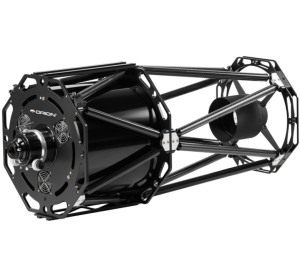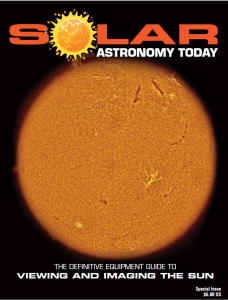Orion Telescopes and Binoculars has released two Orion f/8 Truss Tube Ritchey-Chrétien Astrographs offering observatory-class telescopes for astrophotography enthusiasts. The new telescopes are offered in 14” and 16” options.
 As the Orion team notes, “The telescopes feature premium quartz mirror optics housed in an ingenious truss tube support structure originally developed back in 1935 for the 200″ Hale Telescope at the Palomar Observatory! This exquisitely engineered telescope is optimized for large-aperture astrophotographic excellence – and will take your imaging pursuits to a whole new level! Superb optics, superior design, and sensational affordability come together to make the Orion 16″ f/8 Truss Tube Ritchey-Chrétien Astrograph one spectacular instrument for capturing bright, detailed images of elusive deep-space objects with dedicated astronomical cameras and APS-C and full frame DSLRs.”
As the Orion team notes, “The telescopes feature premium quartz mirror optics housed in an ingenious truss tube support structure originally developed back in 1935 for the 200″ Hale Telescope at the Palomar Observatory! This exquisitely engineered telescope is optimized for large-aperture astrophotographic excellence – and will take your imaging pursuits to a whole new level! Superb optics, superior design, and sensational affordability come together to make the Orion 16″ f/8 Truss Tube Ritchey-Chrétien Astrograph one spectacular instrument for capturing bright, detailed images of elusive deep-space objects with dedicated astronomical cameras and APS-C and full frame DSLRs.”
They continued, “Unlike conventional Newtonian reflector and Schmidt-Cassegrain designs that are susceptible to displaying coma away from the center of the field, the Orion 16″ f/8 Truss Tube Ritchey-Chrétien Astrograph utilizes hyperbolic primary and secondary mirrors to achieve wonderfully flat images that are virtually coma-free. Plus, since there are no lenses involved, images are delightfully free of chromatic aberration, for true-color performance.”
Each of the Orion f/8 Truss Tube Ritchey-Chrétien Astrographs offer a primary mirror and secondary mirror figured from low-expansion quartz glass and with enhanced aluminum coatings to provide 96% reflectivity. The mirror is fixed in place, which eliminates any “image shift” and the secondary mirror is precisely center marked to facilitate collimation.
The Serrurier carbon fiber truss system is thermally very stable, minimizing the effect of ambient temperature changes on the telescope’s focus. Plus, since it is an open tube, the optics cool down faster than solid tube versions. The Serrurier system utilizes two sets of opposing truss tubes on either side of the declination pivot plane, which keep the optical elements parallel to each other no matter how the telescope is oriented, thus keeping optical collimation precisely intact. Stainless steel ball and socket hardware connects the truss tubes to the telescope’s three large CNC-machined aluminum support plates.
The focuser on the Orion f/8 Truss Tube Ritchey-Chrétien Astrographs is a CNC-machined 3″ dual-speed (10:1) linear bearing Crayford focuser which features a stainless-steel rail on the drawtube that provides extra support for up to 11 lbs. of imaging gear without flexure or slippage. The focuser can be rotated 360º for image framing. Both 2″ and 1.25″ non-marring compression ring accessory collars permit the use of 2″ or 1.25″ accessories.
The Astrograph’s tube assembly is equipped with a D-style dovetail mounting bar on both the bottom and top. A dovetail finder scope base is also installed for attachment of any Orion finder scope or reflex sight (sold separately). Three 1.5″ 12V DC cooling fans are mounted on the rear cell to help accelerate optical equilibration to ambient temperature. A battery holder is included (requires eight user-supplied AA batteries), as are one 2″ and two 1″ threaded extension rings for use in reaching focus with various configurations of imaging cameras and accessories. Primary and secondary mirror dust covers are also provided.
Orion 14″ f/8 Truss Tube Ritchey-Chretien Astrograph specifications include:
– Optical design: Ritchey-Chretien
– Optical diameter 356mm
– Focal length 2848mm
– Focal ratio f/8.0
– Optics type Hyperbolic
– Glass material: Low thermal expansion glass
– Resolving power: 0.33arc*sec
– Lowest useful magnification: 50x
– Highest useful magnification: 300x
– Highest theoretical magnification: 701x
– Limiting stellar magnitude: 15.2
– Optical quality: Diffraction limited
– Focuser: 3″ dual-speed linear bearing Crayford
– Secondary mirror obstruction: 166mm
– Secondary mirror obstruction by diameter: 47%
– Secondary mirror obstruction by area 22%
– Mirror coatings/over-coatings: Enhanced Aluminum & Silicon Dioxide
– Backfocus distance: 290.2mm
– Tube material: Steel
– Length of optical tube: 44.9 in.
– Weight, optical tube: 66.1 lbs.
– Additional included accessories: D-style dovetail bars on top and bottom of OTA, Three 12V DC cooling fans on rear cell, Dovetail finder scope base
– Other features: Two 1″ and one 2″ extension rings, Battery holder for fans; requires 8 AA batteries, Primary and secondary mirror dust covers
Orion 16″ f/8 Truss Tube Ritchey-Chretien Astrograph specifications include:
– Optical design: Ritchey-Chretien
– Optical diameter: 406mm
– Focal length: 3248mm
– Focal ratio: f/8.0
– Optics type: Hyperbolic
– Glass material: Low thermal expansion glass
– Resolving power: 0.29arc*sec
– Lowest useful magnification: 58x
– Highest useful magnification: 300x
– Highest theoretical magnification: 799x
– Limiting stellar magnitude: 15.5
– Optical quality: Diffraction limited
– Focuser: 3″ dual-speed linear bearing Crayford
– Secondary mirror obstruction: 189mm
– Secondary mirror obstruction by diameter: 22%
– Secondary mirror obstruction by area: 46%
– Mirror coatings/over-coatings: Enhanced Aluminum & Silicon Dioxide
– Backfocus distance: 310.9mm
– Tube material: Steel
– Length of optical tube: 49.6 in.
– Weight, optical tube: 92.6 lbs.
– Additional included accessories: D-style dovetail bars on top and bottom of OTA, Three 12V DC cooling fans on rear cell, Dovetail finder scope base
– Other features: Two 1″ and one 2″ extension rings, Battery holder for fans; requires 8 AA batteries, Primary and secondary mirror dust covers
You can learn more about the two Orion f/Truss 8 Tube Ritchey-Chrétien Astrographs here.

 And to make it easier for you to get the most extensive news, articles and reviews that are only available in the magazine pages of Astronomy Technology Today, we are offering a 1-year magazine subscription for only $6! Or, for an even better deal, we are offering 2 years for only $9. Click here to get these deals which only will be available for a very limited time. You can also check out a free sample issue here.
And to make it easier for you to get the most extensive news, articles and reviews that are only available in the magazine pages of Astronomy Technology Today, we are offering a 1-year magazine subscription for only $6! Or, for an even better deal, we are offering 2 years for only $9. Click here to get these deals which only will be available for a very limited time. You can also check out a free sample issue here.
The sun is more active than it has been in years! If you’d like to learn more the technology behind solar observing, solar imaging and more, you can check out our free publication, “The Definitive Guide to Viewing and Imaging the Sun”. You don’t have to sign up or provide any information, simply click here and enjoy reading!

